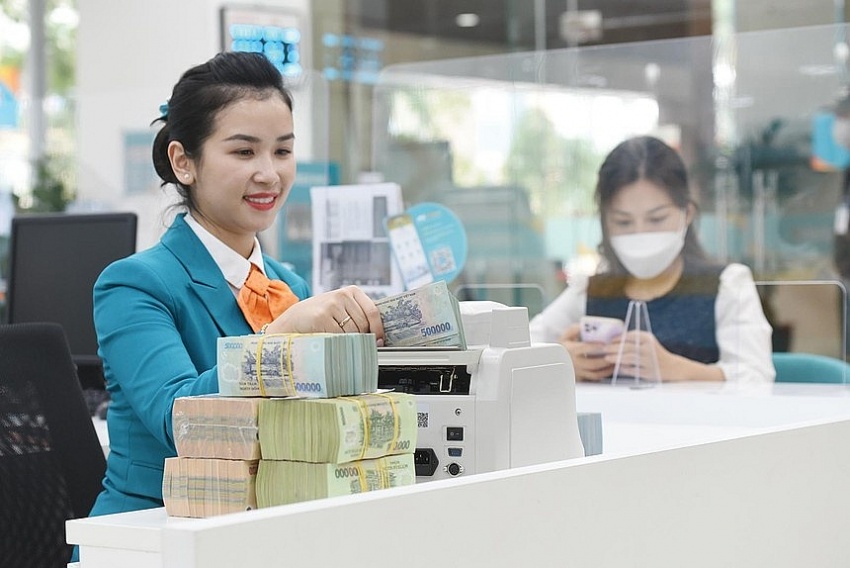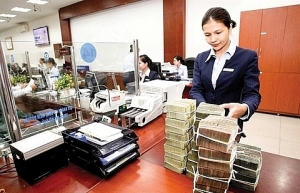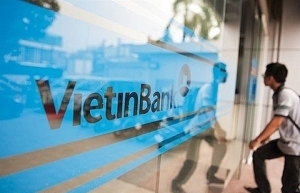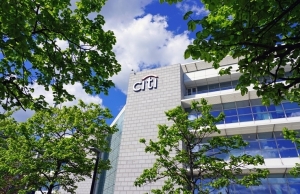Improving liquidity and resilience for local banks
On October 8, SCB announced its highest interest rate of 8.9 per cent per year, for a term of 36 months, and some terms saw an increase of 1 per cent per year compared to previously.
 |
| Improving liquidity and resilience for local banks, Source: tinnhanhchungkhoan.vn |
ABBANK also just announced a new interest rate programme applied from October 10 to December 31, allowing customers who open a new saving account to benefit from a preferential interest rate of up to 8.6 per cent year for a term of 15 months.
At Techcombank, with new automatically revolving deposits opened online, the 1-month to 3-month interest rates are listed at 5 per cent per year. The interest rate for a 6-month term increased to 7.2 per cent per year, while the interest rate for a 12-month term rose to 7.5 per cent per year. Sacombank’s highest interest rate is 8 per cent per year for a term of 36 months.
Not being left out of the interest rate race, VPBank’s 36-month term rate has increased to 7.2 to 8 per cent per year, requiring that customers deposit over VND300 million ($12,430).
“In the third quarter, VND interest rates in the retail market recorded a strong uptrend with an increase of about 0.4 to 1.4 per cent per year for most terms,” said a senior leader at BIDV under condition of anonymity.
In the retail market, the strongest interest rate increase was the joint-stock commercial banks’ group with four to five interest rate hikes in the quarter, such as with Techcombank, MB, TPBank, and SeABank.
After the State Bank of Vietnam’s (SBV) decision to lift the operating interest rate on September 22, all commercial banks in the market, including state-owned commercial banks and joint-stock commercial banks, immediately expanded the listed capital mobilisation interest rate by 0.8 to 1.1 per cent. Many banks have reached the ceiling rate of 5 per cent per year with a term of less than six months.
Movements in the market showed that the main pressure on interest rates in the third quarter was SBV’s tightening monetary policy to stabilise the exchange rate and control inflation. On the one hand, the SBV has tightened the money supply regulation, with a net withdrawal of aboutVND260-280 trillion ($10.8-11.6 billion) through exchange and foreign currency sales. On the other hand, in the last period of the third quarter, the bank also increased a series of operating interest rates, including the refinancing rate, rediscount rate, ceiling deposit rate, and open market operations (OMO) interest rate by about 3 to 3.5 per cent.
The capital mobilisation and credit balance continued to see a sharp narrowing trend, as capital mobilisation growth still faced difficulties and was much lower than credit growth. According to data from the SBV, credit growth reached about 10.96 per cent, as of September 28, which is 6 per cent higher than the growth of capital mobilisation.
“There has been a smouldering but very strong pressure to raise interest rates since the beginning of the third quarter. So while there is no agreement, banks just happened to raise interest rates in October simultaneously,” the BIDV leader said, adding that the VND interest rate in the retail market is expected to increase by about 1 to 1.5 per cent per year in the fourth quarter as pressuring factors continue to dominate.
“Fast and unpredictable developments in the international environment, including geopolitical risks, the trend of monetary tightening of central banks or the risk of recession in some economies in the world, and the inflation and exchange rate pressure in the domestic environment will continue to shape the tightening trend throughout the monetary policy from now to the end of the year,” the BIDV leader said.
Specifically, the SBV will continue to regulate the money supply through the open market channel carefully and at the same time flexibly adjust the OMO interest rate at a high level based on the balance of capital supply and demand in the market.
With other types of operating interest rates, the SBV is expected to cautiously observe macro movements in the international as well as domestic markets and may consider a slight increase of about 0.5 per cent per year for some types of operating interest rates in the year-end period.
“Notably, the VND liquidity of the banking system is expected to continue to face difficulties in the context that cash flows have not improved. The balance between supply and demand for foreign currency in the fourth quarter of 2022 is expected to remain unfavourable. In addition, the increased demand for cash payments at the end of the year also caused the cash flow to be withdrawn from the system into circulation,” the BIDV representative said.
“The credit-capital mobilisation balance is also expected to continue to be under pressure, as credit growth is expected to accelerate in the year-end period, while capital mobilisation growth is still relatively stagnant. The whole year capital mobilisation growth is estimated to be at only 7 to 7.5 per cent, significantly lower than the 14 per cent increase in credit.”
Tran Khanh Hien, VNDirect’s director of analysis, told VIR that the strained liquidity had been a concern for the banking system recently. The first reason comes from exchange rate pressure, as the USD continuously appreciates and has broken the 20-year peak as the US Federal Reserve continues to maintain the tight monetary policy at least until next year. Accordingly, the SBV has had to raise the operating interest rate to balance the exchange rate in the context of foreign exchange reserves no longer being abundant.
“Moreover, the liquidity of the system continues to be under pressure in the context that violations of corporate bond issuance are being investigated. Overnight interest rates on the interbank market in the first two weeks of October reached about 8 per cent at one point, the highest ever,” Hien said. However, Hien assessed that the risk to the liquidity of the banking system was not significant for many reasons.
Firstly, the authorities’ efforts to combat the ‘dollarisation’ of the economy and increase cashless transactions during the period have yielded remarkable results.
“According to our observations, people’s confidence in the banking system has been strengthened, while the habit of hoarding cash has decreased remarkably, helping the system's liquidity,” said Hien.
Secondly, macro-stability and the health of the current banking system have greatly improved. Currently, nearly 20 commercial banks have been recognised as meeting Basel II standards, of which six banks have completed all three pillars. In addition, the ratio of short-term capital and medium- and long-term loans decreased to 34 per cent on October 1 and will decrease to 30 per cent from October 1, 2023.
“Currently, there is no specific roadmap for commercial banks to implement Basel III. However, there have been some pioneering banks in implementing a set of standards to further strengthen capital quality and liquidity capacity, including TPBank, Vietcombank, HDBank, VIB, and OCB,” Hien emphasised.
“It’s crucial to note that improving liquidity risk management is also an important goal for all commercial banks to achieve Basel III standards as it helps improve resilience.”
 | Foreigners legible to make term deposits at local banks Resident and non-resident foreigners in Viet Nam are still permitted to make term deposits at local banks despite some banks saying they would not accept savings deposits from individual foreign customers, the State Bank of Viet Nam has said. |
 | Europe firms may purchase 49pc in local banks The Vietnamese Government may allow European financial firms to buy up to 49 per cent of only two local commercial banks, Nguyen Thi Thu Trang, Director of the WTO Integration Centre at the Vietnam Chamber of Commerce and Industry, said on Wednesday. |
 | Greener finance incentives picked up by local banks Capital injection from international and local lenders is envisaged to help boost green-driven, sustainable and high-value agricultural models, as well as bridge the gap for the climate-finance market which is still at the nascent stage in Vietnam. |
 | Banks enable smooth remittances Local banks are tapping into significant huge overseas cash as Vietnam continues to maintain its growth momentum among the world’s largest remittance beneficiaries. |
What the stars mean:
★ Poor ★ ★ Promising ★★★ Good ★★★★ Very good ★★★★★ Exceptional
Related Contents
Latest News
More News
- Miza Nghi Son green bond marks milestone for sustainable finance (January 19, 2026 | 09:51)
- Higher 2026 growth target puts pressure on credit framework (January 19, 2026 | 09:00)
- VN-Index could reach 2,040 points in 2026 (January 16, 2026 | 16:41)
- Vietnam’s corporate bond market set for a more positive 2026 (January 15, 2026 | 14:10)
- Foreign sentiment towards Vietnam turns more positive (January 15, 2026 | 11:08)
- Wealth management faces skills gap as investor confidence lags (January 13, 2026 | 10:23)
- HDBank completes $100 million international green bond scheme (January 12, 2026 | 16:28)
- Vietnam’s IPO market eyes revival in 2026 (January 09, 2026 | 17:28)
- Brokerage competition tightens as market shares narrow (January 09, 2026 | 15:19)
- Banks set for selective hiring in 2026 (January 08, 2026 | 10:56)

 Tag:
Tag:





















 Mobile Version
Mobile Version